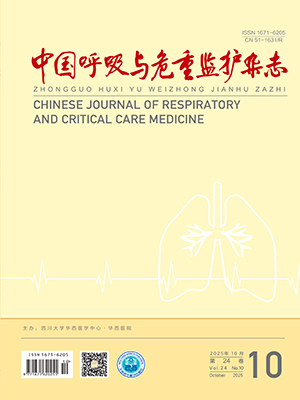| 1. |
Thompson BR. Dysanapsis-once believed to be a physiological curiosity-is now clinically important. Am J Respir Crit Care Med, 2017, 195(3): 277-278.
|
| 2. |
Green M, Mead J, Turner JM. Variability of maximum expiratory flow-volume curves. J Appl Physiol, 1974, 37(1): 67-74.
|
| 3. |
Mead J. Dysanapsis in normal lungs assessed by the relationship between maximal flow, static recoil, and vital capacity. Am Rev Respir Dis, 1980, 121: 339-342.
|
| 4. |
Brooks LJ, Byard PJ, Helms RC, et al. Relationship between lung volume and tracheal area as assessed by acoustic reflection. J Appl Physiol (1985), 1988, 64(3): 1050-1054.
|
| 5. |
Sheel AW, Guenette JA, Yuan R, et al. Evidence for dysanapsis using computed tomographic imaging of the airways in older ex-smokers. J Appl Physiol (1985), 2009, 107(5): 1622-1628.
|
| 6. |
Pellegrino R, Viegi G, Brusasco V, et al. Interpretive strategies for lung function tests. Eur Respir J, 2005, 26(5): 946-968.
|
| 7. |
Chen Y, Dosman JA, Rennie DC, et al. Major genetic effects on airway-parenchymal dysanapsis of the lung: the Humboldt family study. Genet Epidemiol, 1999, 16(1): 95-110.
|
| 8. |
Silverman EK, Palmer LJ, Mosley JD, et al. Genomewide linkage analysis of quantitative spirometric phenotypes in severe early-onset chronic obstructive pulmonary disease. Am J Hum Genet, 2002, 70(5): 1229-1239.
|
| 9. |
Martin TR, Castile RG, Fredberg JJ, et al. Airway size is related to sex but not lung size in normal adults. J Appl Physiol (1985), 1987, 63(5): 2042-2047.
|
| 10. |
Ripoll JG, Guo W, Andersen KJ, et al. Sex differences in paediatric airway anatomy. Exp Physiol, 2020, 105(4): 721-731.
|
| 11. |
Shiota S, Ichikawa M, Suzuki K, et al. Practical surrogate marker of pulmonary dysanapsis by simple spirometry: an observational case-control study in primary care. BMC Fam Pract, 2015, 16: 41.
|
| 12. |
Nourry C, Deruelle F, Fabre C, et al. Exercise flow-volume loops in prepubescent aerobically trained children. J Appl Physiol (1985), 2005, 99(5): 1912-1921.
|
| 13. |
Swain KE, Rosenkranz SK, Beckman B, et al. Expiratory flow limitation during exercise in prepubescent boys and girls: prevalence and implications. J Appl Physiol (1985), 2010, 108(5): 1267-1274.
|
| 14. |
Smith JR, Rosenkranz SK, Harms CA. Dysanapsis ratio as a predictor for expiratory flow limitation. Respir Physiol Neurobiol, 2014, 198: 25-31.
|
| 15. |
Pianosi PT. Flow limitation and dysanapsis in children and adolescents with exertional dyspnea. Respir Physiol Neurobiol, 2018, 252-253: 58-63.
|
| 16. |
Lamprecht B, McBurnie MA, Vollmer WM, et al. BOLD Collaborative Research Group. COPD in never smokers: results from the population-based burden of obstructive lung disease study. Chest, 2011, 139(4): 752-763.
|
| 17. |
GBD 2015 Chronic Respiratory Disease Collaborators. Global, regional, and national deaths, prevalence, disability-adjusted life years, and years lived with disability for chronic obstructive pulmonary disease and asthma, 1990-2015: a systematic analysis for the Global Burden of Disease Study 2015. Lancet Respir Med, 2017, 5(9): 691-706.
|
| 18. |
Smith BM, Kirby M, Hoffman EA, et al. Association of dysanapsis with chronic obstructive pulmonary disease among older adults. JAMA, 2020, 323(22): 2268-2280.
|
| 19. |
Lange P, Celli B, Agustí A, et al. Lung-function trajectories leading to chronic obstructive pulmonary disease. N Engl J Med, 2015, 373(2): 111-122.
|
| 20. |
Mirsadraee M, Boskabady MH, Attaran D. Diagnosis of chronic obstructive pulmonary disease earlier than current Global Initiative for Obstructive Lung Disease guidelines using a feasible spirometry parameter (maximal-mid expiratory flow/forced vital capacity). Chron Respir Dis, 2013, 10(4): 191-196.
|
| 21. |
Allen JL. Airway function throughout the lifespan: pediatric origins of adult respiratory disease. Pediatr Investig, 2019, 3(4): 236-244.
|
| 22. |
Boulet LP. Airway remodeling in asthma: update on mechanisms and therapeutic approaches. Curr Opin Pulm Med, 2018, 24(1): 56-62.
|
| 23. |
McGeachie MJ, Yates KP, Zhou XB, et al. Patterns of growth and decline in lung function in persistent childhood asthma. N Engl J Med, 2016, 374(19): 1842-1852.
|
| 24. |
Salvi SS, Brashier BB, Londhe J, et al. Phenotypic comparison between smoking and non-smoking chronic obstructive pulmonary disease. Respir Res, 2020, 21(1): 50.
|
| 25. |
Arismendi E, Bantulà M, Perpiñá M, et al. Effects of obesity and asthma on lung function and airway dysanapsis in adults and children. J Clin Med, 2020, 9(11): 3762.
|
| 26. |
Forno E, Weiner DJ, Mullen J, et al. Obesity and airway dysanapsis in children with and without asthma. Am J Respir Crit Care Med, 2017, 195(3): 314-323.
|
| 27. |
Quanjer PH, Stanojevic S, Cole TJ, et al. ERS Global Lung Function Initiative. Multi-ethnic reference values for spirometry for the 3 - 95-yr age range: the global lung function 2012 equations. Eur Respir J, 2012, 40(6): 1324-1343.
|
| 28. |
Forno E, Celedón JC. The effect of obesity, weight gain, and weight loss on asthma inception and control. Curr Opin Allergy Clin Immunol, 2017, 17(2): 123-130.
|




